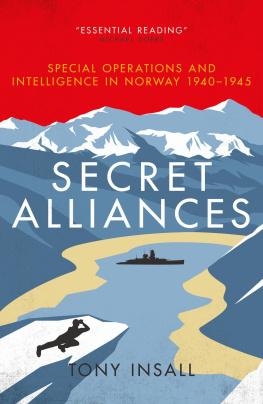Published in the United States of America and
Great Britain in 2020 by
CASEMATE PUBLISHERS
1950 Lawrence Road, Havertown, PA 19083, USA
The Old Music Hall, 106108 Cowley Road, Oxford OX4 1JE, UK
Casemate Publishers 2020
Hardback Edition: ISBN 978-1-61200-771-7
Digital Edition: ISBN 978-1-61200-772-4
Kindle Edition: ISBN 978-1-61200-772-4
All rights reserved. No part of this book may be reproduced or transmitted in any form or by any means, electronic or mechanical including photocopying, recording or by any information storage and retrieval system, without permission from the publisher in writing.
A CIP record for this book is available from the British Library
www.casematepublishingservices.com
For a complete list of Casemate titles, please contact:
CASEMATE PUBLISHERS (US)
Telephone (610) 853-9131
Fax (610) 853-9146
Email:
www.casematepublishers.com
CASEMATE PUBLISHERS (UK)
Telephone (01865) 241249
Email:
www.casematepublishers.co.uk
Dedicated to the courage and sacrifice of the men and women who served, as well as the patriots of the resistance groups with whom they fought and died.
The life that I have
Is all that I have
And the life that I have
Is yours
The love that I have
Of the life that I have
Is yours and yours and yours
A sleep I shall have
A rest I shall have
Yet death will be but a pause
For the peace of my years
In the long green grass
Will be yours and yours
and yours
SOE agent Violette Szabo, GC, used these lines as a code poem on her second and final mission. It was written by Leo Marks, a SOE cryptographer, after he learned of the death of his fiance. He provided it to Szabo, but did not tell her of its origin.
Leo Marks, Between Silk and Cyanide
(London: Harper Collins, 1998)
INTRODUCTION
T HE S PECIAL O PERATIONS E XECUTIVE (SOE) AND Office of Strategic Services (OSS) were created to fight an unconventional war at a time when the normal means to bring the fight to the enemy were lacking.
At the beginning of World War II, Britain faced a fearsome wartime aggressor the Axis alliance of Germany, Italy and later Japan and realised it had a need for special units to do things their regular military could not. That need was to oppose the Axis indirectly in unexpected places, behind enemy lines and on the periphery until its military was ready and able to fight a conventional war.
The United States would join in the fray nearly two years later. As was quite often the case with innovations in the early 20th century, the British created their Special Operations Executive first. The Americans would follow with the Office of Strategic Services in 1942.
In sum, both SOE and OSS were conceived to fight an unconventional or subversive war some would say a dirty war against the Germans. While SOE was essentially the action arm of British intelligence (albeit separate of the Secret Intelligence Service), OSS would serve both roles, intelligence and special operations, for the duration of the war.
From the outset, the two organisations were distrustful of each other and often demeaned their partners capabilities before they had even met. SOE operatives regarded the Americans as inexperienced, while the American OSS often saw the British as arrogant. Differing views on the political aspects of the war added to the distrust. But the distrust each organisation had for each other was probably no worse than the issues they had with their own militaries and diplomatic services. Nevertheless, once they realised they were on the same side they banded together well to fight their common enemies.
In 1938, Europe was still traumatised by the horrific losses of sons, fathers and husbands the so-called lost generation in World War I. Most sane people wished nothing more than to avoid another war. Among these were British and French Prime Ministers Neville Chamberlain and Edouard Daladier honourable but short-sighted men who thought they could negotiate a lasting peace with Germany.
But a few far-sighted leaders saw the futility of diplomacy with Adolf Hitler. At the same time, Japans militancy in the Far East, as well as Italys aggression in Africa, demonstrated those countries expansionist aims. The prospects of conflict elevated and muted alarm bells began to ring in London, Paris and finally Washington. In London there were men like Stewart Menzies, Hugh Dalton, Colin Gubbins and, of course, Winston Churchill, who realised the gloves would have to come off. In Washington, which did not have Britains recent experiences with revolutionary uprisings like those in Ireland, Palestine or India, there were fewer who saw the role that intelligence and irregular operations would serve in the coming war. Among those who did understand the need were special men: Frank Knox, William Donovan and Franklin Roosevelt.
Once both countries had adopted the concept, the two organisations developed at a rapid pace, largely due to the dynamism of the chosen directors, Hugh Dalton for SOE and William Donovan for OSS, and their abilities to work around government stove-piping.
Although the ranks of SOE and OSS were initially filled with Britons and Americans many of them expatriates from the target countries Frenchmen, Belgians, Norwegians, Poles and other nationalities were quickly recruited to meet the requirement for men and women who could operate clandestinely in their home countries.
Until the end of the war in 1945, these two secret units would contribute much to the fight, and as many as 25 per cent of their operatives were killed in combat or executed after their capture. Some were sent to their deaths in concentration camps.
The history of SOE and OSS would take years to be told, and many stories remain secret. David Stafford, a historian of SOE, wrote in 1982: The obsession with secrecy is perhaps the true English disease. That is still very much the case. The story of the OSS is easier to tell because its history was more completely recorded, catalogued and eventually declassified. In fact, the OSS is the only intelligence agency of any nation to have its records fully open to public inspection. Much of SOEs files and history were absorbed into the SIS after World War II and little has been revealed. Other than personnel files (and not all of them at that) and some operational details, the official record is scant. SIS is notoriously reluctant to share its secrets, even its old ones.
Previous books on the SOE, specifically M. R. D. Foots SOE, An Outline History and SOE in France and William Mackenzies The Secret History of SOE , provided much of the British story, while the War Report of the OSS, Volumes 1 and 2 along with Aaron Lindermans Reclaiming the Ungentlemanly Arts and John Chamberss works on the OSS for the US Park Service informed much of the US side of things.














